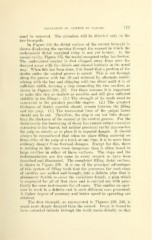Page 401 - My FlipBook
P. 401
EXCAVATION OK CAVITIES BY CLASSES. 175
must be removed. The attention will be directed only to the
two bicuspids.
In Figure 234 the distal surface of the second bicus]iid is
shown displaying the opening through the enamel in which the
undermined distal marginal ridge is not yet broken. In the
mesial cavity, Figure 235, the mesial marginal ridge has broken.
The undermined enamel is first chipped away from over the
decayed areas with the chisels and enamel hatchets in the usual
way. When this has been done, it is found that a portion of the
dentin under the central groove is sound. This is cut through
along the groove with bur 10 and widened by alternate under-
mining with the bur and chipping with the chisel until it is of
sufficient width, forming a step connecting the two cavities, as
shown in Figures 236, 237. For three reasons it is important
to make this step as shallow as possible and still give sufficient
stability to the fillings: (1.) The strength of the tooth must be
conserved in the greatest possible degree. (2.) The greatest
thickness of dentin possible should remain between the filling
and the pulp. (3.) The recessional lines of the pulpal horns
should not be cut. Therefore, the step is cut but little deeper
than the thickness of the enamel at the central groove. For the
distal cavity the burrowing of decay has caused rather excessive
extension to the buccal, but neither proximal cavity approaches
the pulp so closely as to place it in especial danger. It should
always be remembered that when we place filling material on
three sides of the pulp of a tooth at one time, it is in more than
ordinary danger from thermal changes. Except for this, there
is nothing in this case more dangerous than is often found in
large cavities in either of these surfaces. The steps and the
instrumentation are the same in every respect as have been
described and illustrated. The completed filling, distal surface,
is shown in Figure 238. It is one of the principal advantages
of this system of filling teeth that the processes for each class
of cavities are unified and brought into a definite plan that is
abundantly flexible to cover the variations found; a plan which
is employed for all of that class and is carried out with prac-
tically the same instruments for all cases. This enables an oper-
ator to work to a definite end in each different case presented.
A higher degree of accuracy and better speed in operating are
attained.
The first bicuspid, as represented in Figures 239, 240, is
much more deeply decayed than the second. Decay is found to
have extended entirely through the tooth mesio-distally so that


